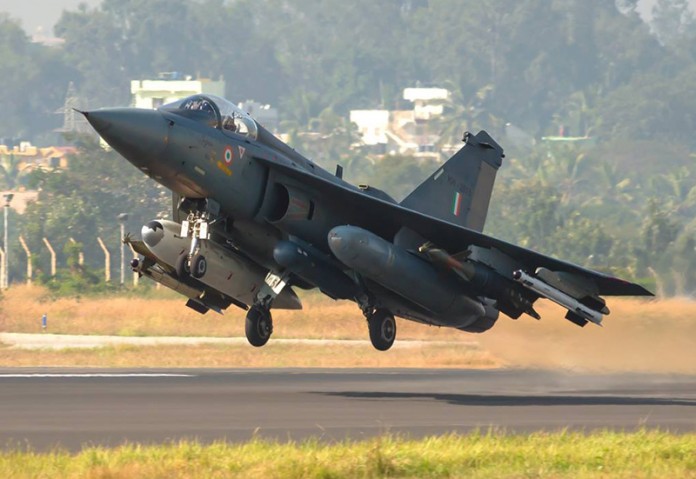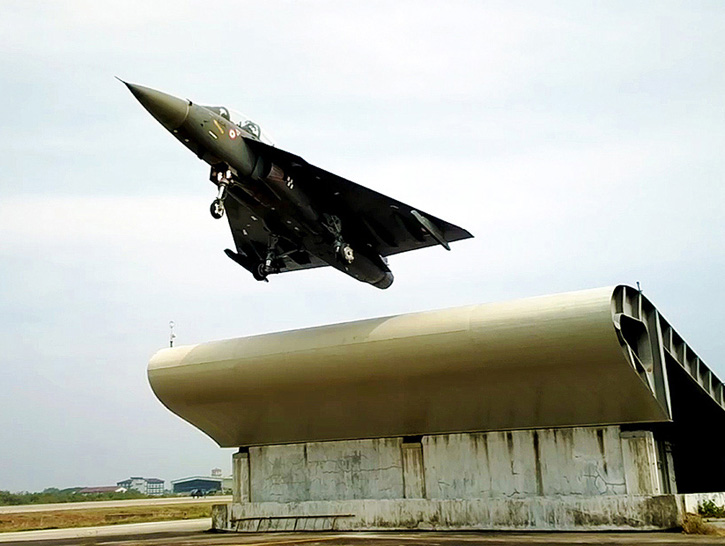

The Indian Air Force (IAF) today received the first indigenously built Light Combat Aircraft (LCA) designed by the Aeronautical Development Agency (ADA) and built by Hindustan Aeronautics (HAL). The LCA, also named ‘Tejas’, was handed over today by Defense Minister Manohar Parrikar to the Indian Air Force Chief Air Marshal, Arup Raha, in Bangalore. Parrikar congratulated all parties involved in the program for their achievement and called upon them to ‘think out of the box’ to meet the schedule and challenges by applying the right management tools. “Work culture should modify by adapting better technology and tools to achieve better results” Parrikar urged his audience.

LCA-SP1, the first aircraft handed over to the air force, rolled off the HAL assembly line in September and, since then, has been inspected to Initial Operational Clearance II, attesting its airworthiness for operational missions. Previous Tejas fighters delivered to the IAF since 2011 have been used primarily for training, as they were qualified only under ‘IOC-I’ rating. Full operational clearance of the LCA is expected by the end of 2015.
Initially HAL will produce only six aircraft per year, the goal is to build 20 aircraft by 2018 to equip Bangalore based No. 45 Squadron (Flying Daggers) – the first IAF squadron to fly the Tejas. Production will slowly ramp up to 16 aircraft per year. Overall the IAF plans to deploy 10-14 squadrons, each equipped with 21 Tejas.
As part of the extensive testing, LCA performed, more than 2,800 sorties from different locations across India, from the highest, operational airfield at Leh in the Himalayah, testing cold, winter operations, to desert conditions tested in Jaisalmer, Jamnagar, Uttaralai Gwalior, Pathankot and Goa. The aircraft performed extensive weapon delivery testing, launching air/air missiles and dropping standard and guided bombs using laser designation provided by Litening pods.
32 Years of Development
Meeting deadlines has not been the strong side of the LCA program. Launched in 1983 to replace India’s Russian-made MiG-21 fighter jets, the LCA took 32 years to mature to this stage – an extremely long process, even by Indian standards. Most of the MiGs it was supposed to replace have already been phased out; about a hundred that still remain in service are to be retired by 2017. With the French Rafale contract signing nowhere in sight, and LCA gearing up slowly to deliver only a single squadron in two years, the IAF will have to deactivate 10 squadrons by 2017, against a force structure requirement of 42 squadrons originally planned.

Development costs have been high – an amount equivalent to US$2.75 billion (17,000 crore) has been spent to date on the development and manufacturing of 15 prototype and pre-production aircraft. The IAF plans to operate 200 single-seat fighters and 20 twin-seat trainers, while the Indian Navy expects to field 40 naval variants of the aircraft, designed to operate from aircraft carriers equipped with ski-jump decks.
As production gears up, the Tejas is expected to begin to produce a return on investment – the unit cost of the aircraft is expected to be between $27 and $32 million (170-200 Crore), which is less than half the cost of an Indian-built Su-30MKI and significantly lower than other, fully equipped western alternatives, such as the Gripen and F-16. However, the Tejas will be more expensive than the less=equipped Chinese or Korean fighters, such as the JF-17 and F/A-50.
Subscribe to access the full version of this article
Among the causes for the lengthy development cycle was the Indian insistence on the local development of technology and manufacturing capabilities. As opposed to the Chinese developers which relied on spying and the reverse engineering of foreign designs, the Indian scientists and engineers did it all by themselves. As the program dragged along, and certain foreign technologies nevertheless still had to be used, the Indians obtained them with permission and through dialogue. They should be commended for their persistence and dedication in achieving their goals without the dubious Chinese methods.
Indian Made, but Not totally indigenous
Although India presents the LCA as an indigenous aircraft, even HAL admits it is not fully domestic, as its engine, some of the avionics, and some of the weapon systems are foreign. In fact, only 60 percent of the aircraft is ‘indigenous’. When the program began the intention was to make the LCA fully indigenous. This would have required Indian industry to master new production techniques and to develop an indigenous engine, as well as indigenous electronic, electro-optical and electro-mechanical systems, and software systems, including flight controls and mission management systems.



















